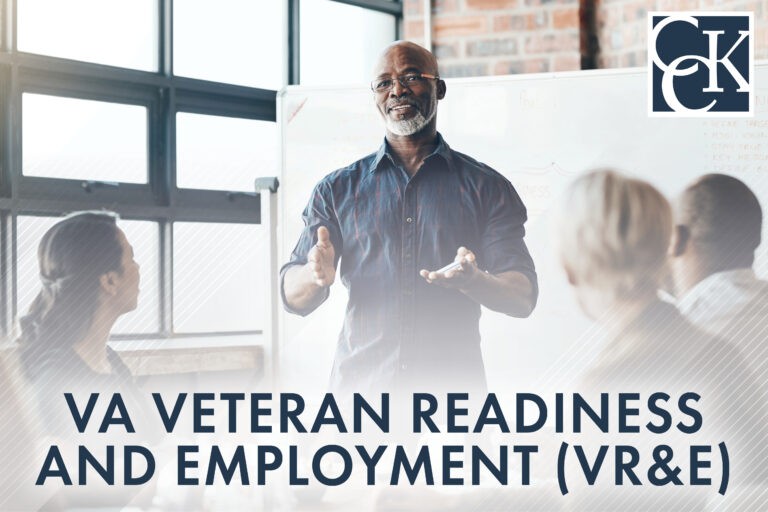Chapter 31 VA Benefits: Veteran Readiness and Employment (VR&E)

CCK Law: Our Vital Role in Veterans Law
Veteran Readiness and Employment (VR&E), formerly called VA Vocational Rehabilitation and Employment and also known as Chapter 31 benefits, is a Department of Veterans Affairs (VA) program for veterans with service-connected disabilities that limit or prevent their ability to work. VR&E offers training and assistance to disabled veterans seeking employment opportunities.
Am I Eligible for Veteran Readiness and Employment (VR&E)?
To be eligible for VR&E, veterans need to have received an other-than-dishonorable discharge and be rated at least 10 percent for a service-connected disability.

Veterans are eligible to apply for VR&E up to 12 months from the date of notification of either their separation from active duty or their VA rating decision for service-connected disability benefits. Once their VR&E application is received, VA will schedule the veteran for an initial evaluation with a Vocational Rehabilitation Counselor (VRC). According to VA, the comprehensive evaluation typically includes:
- An assessment of the veteran’s interests, aptitudes, and abilities;
- An assessment of whether the veteran’s service-connected disabilities impair their ability to find and/or hold a job using the occupational skills they have already developed; and
- Vocational exploration and goal development leading into employment and/or maximum independence in the veteran’s daily living at home and in the community.
Based on this evaluation, the VRC will determine if the veteran is entitled to receive VR&E services.
NOTE: If you are service-connected below 10 percent or are beyond the 12-month eligibility window, then you can still apply and be found eligible for VR&E as long as VA finds that you have a serious employment handicap.
How to Apply for VR&E Benefits
To apply for VR&E (i.e., Veteran Readiness and Employment) benefits, VA first asks veterans to complete a 15-minute online orientation. According to VA, the orientation can help you decide if the program would be of service. Then, you can fill out and submit VA Form 28-1900.
Veterans can file VA Form 28-1900 in one of four ways:
- Online – using VA’s eBenefits platform;
- By mail – print, fill out, and direct to the Department of Veterans Affairs, VR&E Intake Center, PO Box 5210, Janesville, WI 53547-4444;
- In-person – bring the completed form to the nearest VA Regional Office; or
- With a legal representative – complete the form with the assistance of a Veterans Service Organization (VSO) or a VA-accredited attorney or agent.
What Happens if I’m Eligible for VR&E Benefits?
If you are eligible for the Veteran Readiness and Employment program, then VA will schedule you for a meeting with a Vocational Rehabilitation Counselor. The VRC will assess your skills, employment options, limitations, whether any training needs to take place, and ultimately help you choose a VR&E program track. You will also work with your VRC to establish a rehabilitation plan that, according to VA, “outlines the resources and criteria that will be used to achieve employment or independent living goals.”

After you develop this plan, your counselor will place you in one of the five program tracks. These tracks are reemployment; rapid access to employment; self-employment; employment through long-term services; and independent living. Placement in each track depends on the veteran’s needs and abilities due to their service-connected disabilities.
Veterans will continue to work with their counselor to achieve their rehabilitation goals. Continued assistance of the counselor can include tutoring assistance; job skills training; and adjustment counseling if necessary.
The goal of VA vocational rehabilitation is to place veterans into suitable employment, meaning employment that does not worsen the veteran’s conditions and is fitting to the veteran’s abilities and limitations.
VR&E Benefits vs. Total Disability Based on Individual Unemployability (TDIU)
Veteran Readiness and Employment can be a useful tool for veterans who are disabled and need assistance with finding and maintaining employment. However, VA can determine that a veteran is not eligible for VR&E benefits if their service-connected conditions prevent them from benefiting from the program. This means that if VA determines that your conditions are too severe for you to benefit from job training and employment assistance, then they will not offer you these services.
If you are service-connected for disabilities that prevent you from obtaining and maintaining substantially gainful employment, then you may be eligible for Total Disability for Individual Unemployability (TDIU). TDIU allows veterans without 100 percent VA ratings to receive compensation at the 100 percent level if their service-connected disabilities prevent them from working. Check out our page to learn more about TDIU.
About the Author
Share this Post
